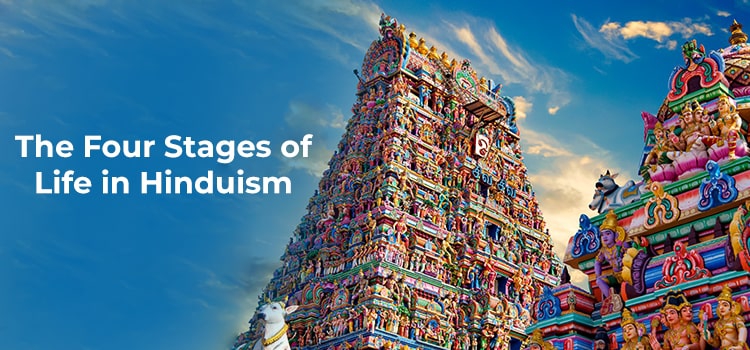The Four Stages of Life in Hinduism
According to Hindu philosophy, there are 4 stages of life. These are called asramas. This concept aims to provide structure and guidance for daily life. However, most Hindus follow only the first three stages. There can be specific ages for each stage (the first is usually below 18 or 20 years, for instance). But nowadays, the age associated with each stage can vary considerably.
A person’s lifespan had 4 parts, as people used to live up to 100 years in the old days. So each stage covered 20- 25 years. Usually, the second asrama is the longest one.

The 4 stages of life are:
1) Brahmacharya
2) Grihastha
3) Vanaprastha
4) Sannyasa
Brahmacharya - Asrama
Brahmacharya, or the first stage of life, was the student stage. It is when a person prepares for success in the later stages. Religious training was a part of this stage, and it helped lay the foundation for spiritual practice. Education normally started between 5 and 8 years of age and continued upto age 14 to 20. Education for both boys and girls is mentioned in the Scriptures. In modern times, this is the period that covers college, vocational training, etc., before one starts a family. Brahmacharya is also related to one of the yama (core ethical principles of Hinduism). It refers to a mode of behavior: traditionally, it meant celibacy, but it is also more liberally interpreted sometimes to mean self-control and moderation (also fidelity in romantic relationships in the later stages). However it is interpreted, this meaning of Brahmacharya is a value that is idealized for this initial stage of life.
During this learning phase of life, one was expected to be celibate and gain knowledge from one's Guru or teacher. In ancient times, this stage began at the age of 8. The student is introduced to his teacher through a ceremony called Upanayana.
Grihastha- Asrama
Grihastasrama is the second stage of life. This is the “householder” stage, where, after finishing school, people get married, raise a family, and maintain a home. Some may choose not to have children or remain unmarried for various reasons. But most Hindus continue to be spiritual even as they raise families. Marriage has great importance in Hindu culture. The Hindu scriptures speak in detail about how to make a marriage successful. People are encouraged to produce and distribute wealth. This fulfills the goal of artha, and they also experience pleasure (kama) while behaving ethically (dharma).
But the exact details of how one does this can be different. Overall, people try to provide for their families and be productive members of society. This stage continues until the person’s children have completed their studies and the person is ready to move on to the subsequent stages.
Thus, during this stage, one gets married and fulfills his duties towards his wife, children, father, and mother. This is the longest of all the four stages of life. During this time, one uses the knowledge gained during the Brahmacharya to lead one’s life. One can enjoy the pleasures of life while securing wealth. This stage ends at 50 years.
Vanaprastha- Asrama
The third stage, Vanaprastha, starts after a person has fulfilled their responsibilities to their families. Literally, it means ‘going to the forest’. In ancient times, those who were in this stage would begin to detach themselves from family life and material pursuits. They would become celibate, give away their possessions to their children, and enter the forest to spend more time on spiritual practice, living among other people who, like themselves, seek solace, freedom, knowledge, and peace. They also survive on alms and live like a hermit.
However, nowadays, people do not retire to the forest. Instead, they prefer to give back to society as they become more spiritual. Volunteering, reading the Scriptures, going on pilgrimages, and spending time in ashrams are some of the preferred activities during this stage. The idea is to pursue spiritual practice with a commitment to selfless service or Seva and the hope of attaining Moksha (liberation).
One usually did not enter this stage if one’s children were not independent. Daughters need to be married off, and sons need to have a livelihood for themselves. This means that the person has successfully completed his Grihastha- Asrama.
Sanyasa- Asrama
Sanyasa, the fourth stage, is about total renunciation. This stage usually starts at 75 years. But some Hindus may have a calling to pursue scriptural study and a monastic lifestyle under a guru early in their life. Their aim is to seek Moksha, and so they enter this stage at a young age. Others who have gone through the earlier stages enter Sanyasa after the 3rd stage. In both cases, they have fulfilled all obligations in their own way and hence, are free to focus entirely on spiritual growth. In this stage, people lead very simple lives, surviving on very few material possessions and upholding nonviolence. They eat mostly fruits and other edibles in the jungle and avoid cooked food. There is no unnecessary interaction or contact with others. There is also no need to take care of the body. The primary aim of those undergoing this stage is to get Moksha, or liberation from the cycle of birth and rebirth.
Conclusion
The Asrama system has been prevalent since the 5th century B.C.E. in Hindu society. It has been described in classic Sanskrit texts like Asrama Upanishad, the Vaikhanasa Dharmasutra, and a later work called Dharmashastra.
According to historians, these 4 stages of life were seen more as 'ideals' than as common practice. Even from its inception, after the first Asrama, a young adult had the freedom to choose which of the other asramas he wanted to pursue for the rest of his life. Today, it is not mandatory for a Hindu to go through the four stages of life, but the concept remains an important part of Hindu socio-religious tradition.



















